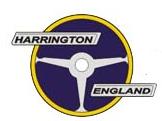 |
 |
|
|
First, the VIN does not indicate when a Harrington conversion was completed. It was applied to an Alpine at the Rootes factory when the car was completed and before it left Rootes for the conversion. It usually took at least two months for the conversion. There are cars which are registered and licensed almost a year after they left Rootes. There are also some cars with First Registrations dates showing a much shorter conversion period but the loss of all records means that these instances remain anomolous. The Sunbeam Alpine Owners Club of America (SAOCA) website has a list of Alpine build dates by week.
HC's and HD's have no numbers produced mentioned anywhere (due to lost records). The estimated 20 HC's were produced in parallel with HLM's so 20 cars seem to be realistic for a period of six months, same amount of HLM's for same period. The production tempo was slow due to different conflicts, union/economy/strikes and change of board. Or perhaps not as many were built as the figures say. Some VIN's are from donor cars if the car has been rebodied. There are cars which are Alpines with a Harrington roof and also cars which are carrying the original VIN's on a rebodied car (not legal). The most famous one is this. |
 |
| It's a reconstruction of the car (just roof and trunk lid are original) which raced at Sebring in 1962/63 driven by Filippo Theodoli/Freddie Barette. Raced at Goodwood 2014. This car was sold at an RM Sotherby auction in Aug 2016 as an original car for more than £100K. RM was informed and knew that it wasn't the original body. |
| [Webmaster Note: the U.S. DMV and UK. DVLA are clear about rebodied cars needing to retain the VIN of the donor vehicle. In the above case neither the car nor the donor vehicle were originally sold in the UK, and therefore the DVLA have no knowledge of, or interest in, any VIN discrepancy. The main unique component of a Harrirngton is the roof and therefore many people argue that saving a Harrington roof is the most important factor, especially if there is a history behind the item, and also if there has been a high quality restoration. Certainly the owner of #55 will be able to enjoy many international motorsport events as a result and the Harrington community will benefit from having the cars story re-told. See the article "The Car That Legitimately Wore The Ferrari Crest"] |
|
The cars not converted by H. Ltd. and are not original true Harringtons. There were some left over roofs for the HD's stored by an old employee which most likely are now in circulation
|
 |
|
There are three really early Harringtons made on Alpine Series I body (PBW 262 (still exists) KRU 245 and USY 266 (still alive). In the beginning of the production it's believed that the cars once were registered as Alpines and purchased by Harrington Ltd from the open market for conversions but the latter part of the production which were made parallel with HLM's were coming to H.Ltd in batches of approx. 5-8 cars delivered by Rootes.
|
 |
| The cars for the USA are presented in the feature "Promotional HLM". Once car which was often seen when the HLM was introduced was the B9104381 OD LRX car, the first LHD. (current existance unknown) |
 |
|
One can see in the register groups of cars with VIN's after each other or close to. The single cars might have been privately Alpines brought to H.Ltd for conversion or a dealer wanting a Harrington in the show room or a" Special order" (see Prince car).
|
 |
|
None of the 20 HC's and approx. 10 HD's engines had any Hartwell tuning. Just as an option.
|
 |
| Meanwhile, the Triumph GTR 4 Dové began to be produced in a trial to increase the business economically. The HD on Alpine 3 base lasted until Dec 1963, just a handful were made. After that some more GTR4's were made and another hand full of HD's on Alpine IV base together with a couple of GTR4A (a total of 50-60 Dové units) until close down of factory late 1965 when the only Harrington Tiger was made! see Model presentation |
 |
|
|